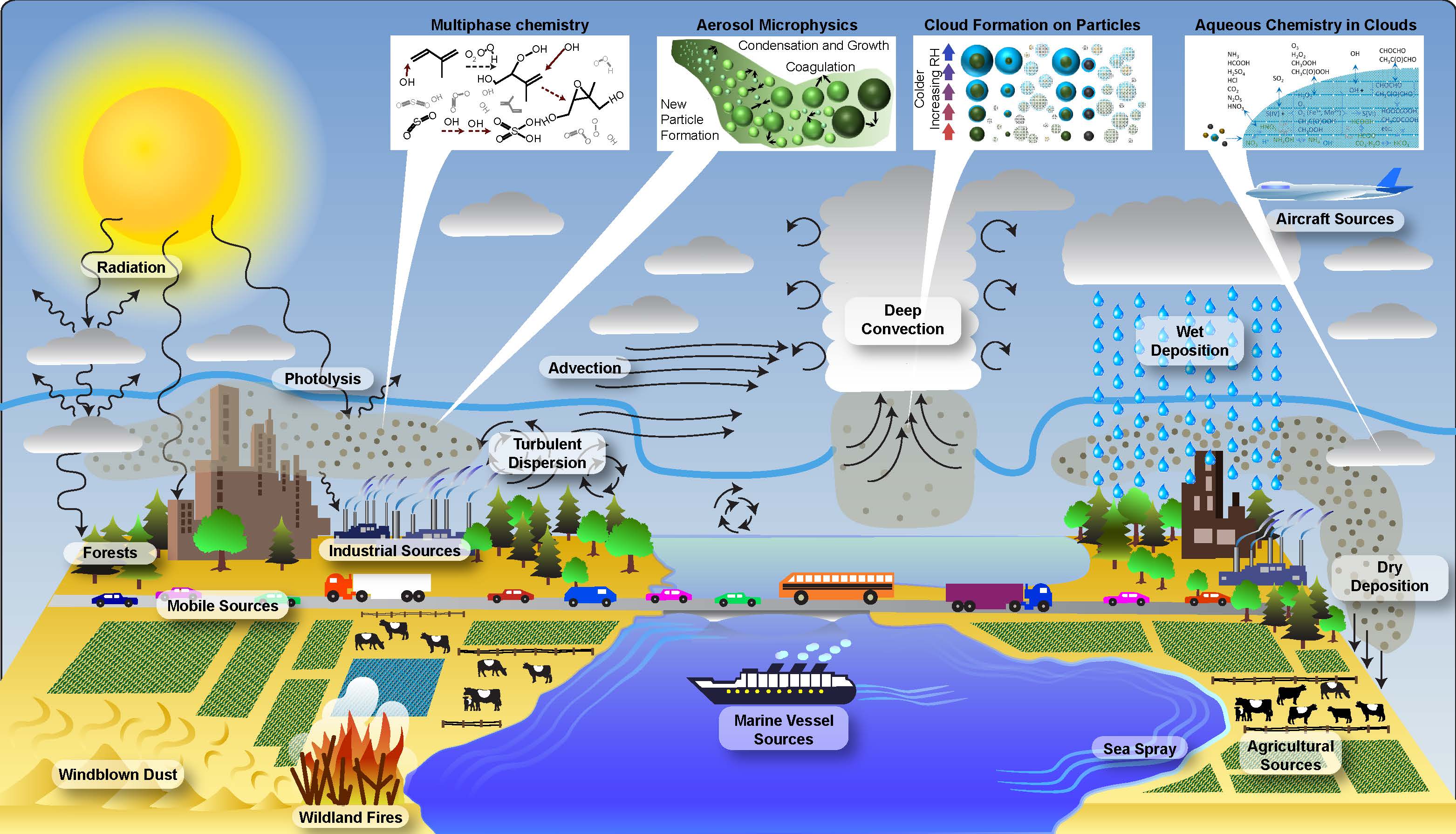Overview of Science Processes in CMAQ
- Radiation
Light can excite airborne molecules and turn them into other molecules. - Advection
When pollutants are emitted into the atmosphere from smoke stacks, tailpipes, fires, trees, dust storms, etc., they are transported by the wind (advection) and diffused by turbulence. - Turbulent Dispersion
The atmosphere is a generally turbulent environment, especially close to the Earth’s surface, which means it contains several eddies of different length and time scales affecting pollutant transport. Mixing and random movement of eddies result in a diffusion-like transport that is often orders of magnitude stronger than molecular diffusion. - Deep Convection
Clouds, especially thunderstorms, transport surface-based emissions to higher altitudes where these chemicals can live longer and be transported around the globe by the stronger winds aloft. - Wet Deposition
Clouds produce rainfall, returning chemical compounds back to Earth's surface through wet deposition. - Aircraft Sources
Anthropogenic emissions are emitted by aircraft. - Marine Vessel Sources
Anthropogenic emissions are emitted by marine vessels. - Mobile Sources
Anthropogenic emissions are emitted by mobile sources such as cars, trucks, and buses. - Industrial Sources
Industrial processes produce anthropogenic emissions. - Forests
Forests are a type of biogenic emission source and can contribute to the emissions of VOC, NOx, and greenhouse gases. - Windblown Dust
Windblown dust has important effects on the atmosphere (e.g. changing visibility) and human health (e.g. causing asthma attacks and skin irritation). - Wildland Fires
Fire sources are event-based sources and can be classified as wildfires, prescribed fires, crop residue burning, and range land burning. - Sea Spray
Sea spray is an important component of particles in the atmosphere of coastal locations. The sea salt in these particles can react with anthropogenic pollution in urban areas near the coast, changing the way it’s transported and deposited. - Agricultural Sources
Agricultural lands can contribute to biogenic emissions. - Dry Deposition
Dry deposition is the gravitational sedimentation of particles during periods without precipitation. These particles include: aerosols, sea salts, particulate material, and adsorbed/reacted gases captured by vegetation. - Photolysis
Photolysis provides the energy required for many chemical reactions to occur in the atmosphere. - Multiphase Chemistry
Heterogeneous reactions in CMAQ involve both the gas and aerosol phase. It is well-known that some reactions, which happen to be very slow in the gas-phase alone, are sped up by the presence of a surface that stabilizes the reacting molecules. - Aerosol Microphysics
The major goal of CMAQ’s aerosol module is to comprehensively account for particles' introduction to and removal from the atmosphere as well as the impacts atmospheric processing has on their properties along the way. - Aqueous Chemistry in Clouds
Clouds can help to “clean” the atmosphere by taking up pollutants from the air and raining them out. - Cloud Formation on Particles
Forming on small particles in the air, the water droplets that make up clouds and fogs offer a medium for gases in the atmosphere to dissolve and react with each other

Overview of Science Processes in CMAQ
CMAQ is a first-principles scientific computer model that comprehensively represents the most important processes affecting air quality and atmospheric chemistry. Emissions from a wide range of sources are included, as well as transport by winds and deposition due to precipitation events. CMAQ uses an extensive database of atmospheric chemical reactions to predict the chemical production and loss of hundreds of pollutants as they are carried downwind from their sources. In addition to gas-phase species, many pollutants exist partially or wholly in airborne particles, giving them the potential to interact with incoming solar radiation and clouds in complicated ways.
A major challenge for models like CMAQ is capturing the variability in human-driven emissions and weather patterns across the U.S. or around the globe. In addition to variations in space, CMAQ methods have to deal with emission and weather changes that happen over decades, throughout the seasons, and even over the course of a day. Even with these challenges, it’s important for CMAQ to represent the atmosphere and all its complexities accurately, since gases and particles included in the model can have major impacts on public health and the environment.
